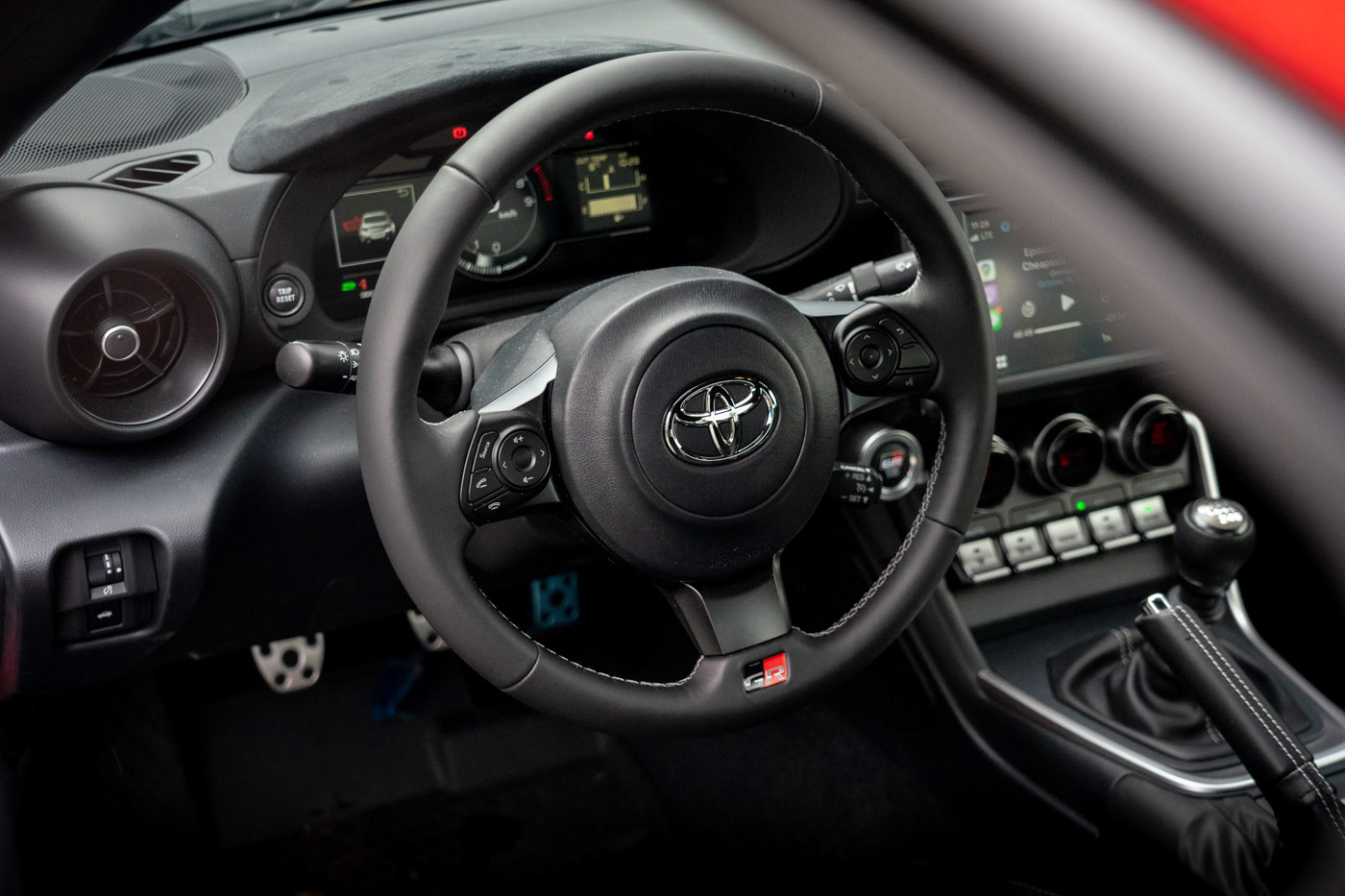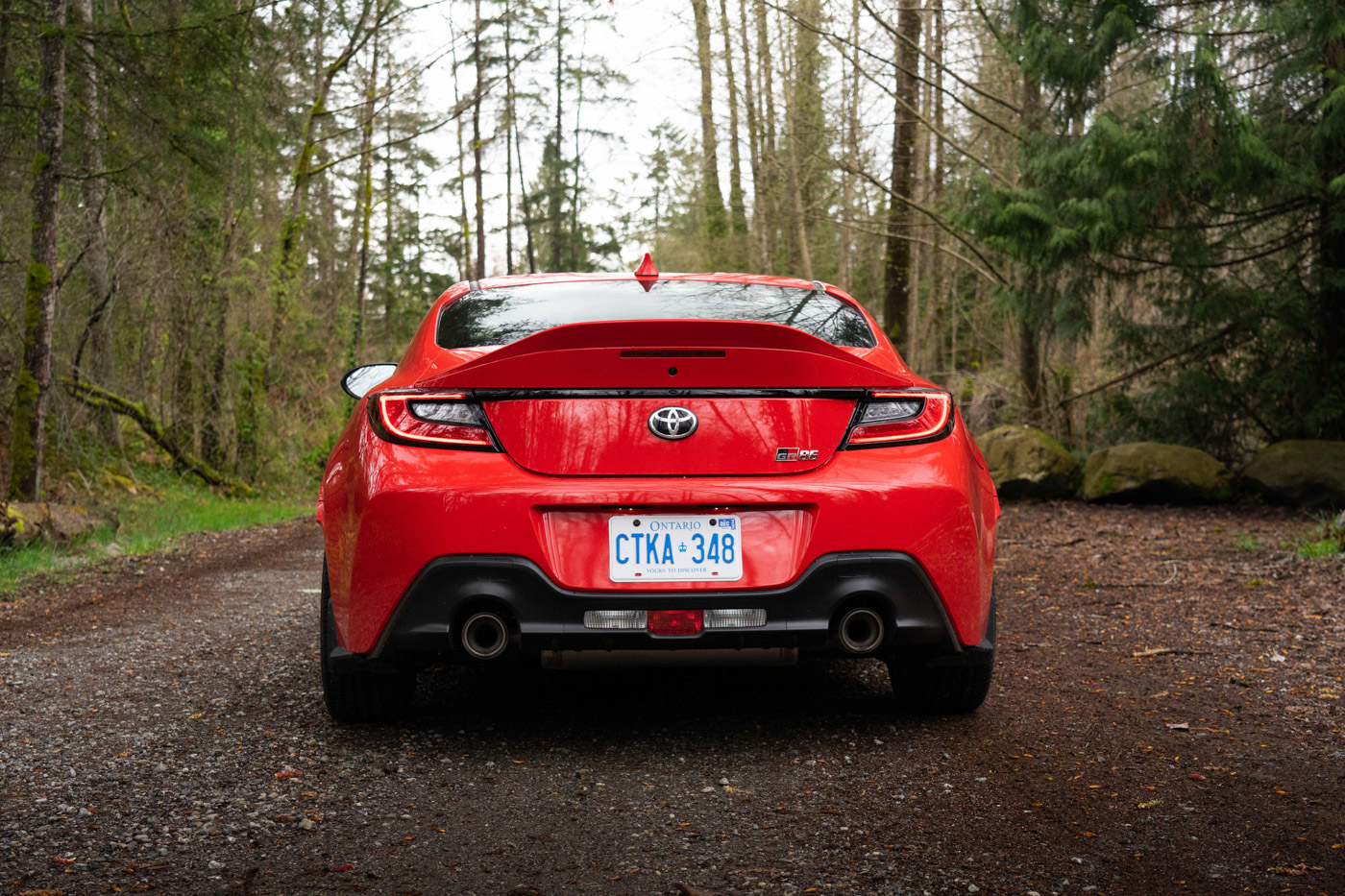On a busy street in North Vancouver, a parked car stops a woman in her tracks. “That’s what Corollas look like now?” The vehicle in question, a blister-fendered little hatchback with improbable triple-tailpipes, sits with its wide grill like a smug grin. It’s a GR Corolla, one of the most exciting new machines on the market—and it’s not the only thrill from Toyota these days.
Excitement is not generally what Toyota does best. For the average Canadian, a car is the largest consumer purchase besides housing, and a safe bet works best. Reliability and resale rule the charts, which is why the two bestselling passenger vehicles in Canada are the Toyota RAV4 crossover and the compact Corolla.
Not this Corolla. Based on the practical hatchback version of Toyota’s long-running economy car, this thing is such a bundle of lunacy that you can buy it in a version that doesn’t even have rear seats. It’s got wide tires, an all-wheel-drive system that can be adjusted to a rear-drive bias, and a triple-cylinder 1.6-litre engine turbocharged up to 300 horsepower. It sounds like a rally car, and if you take it to the racetrack it’ll hassle BMWs and Porsches all day.

The 2023 Toyota GR Corolla.
Slot the manual-only gearbox into first and the GR Corolla rockets off down the road, that three-cylinder engine percolating with pressurized air. It’s like Toyota set out to build a tribute to the golden era of Subaru vs. Mitsubishi in the World Rally Championship of the late 1990s. Mitsubishi long ago left the field, and Subaru doesn’t build its mighty STI anymore, so why is Toyota still on the track?
The answer boils down to that two-letter prefix, GR. GR stands for Gazoo Racing, the team name under which Toyota competes at world-class motorsports events like the 24 Hours of Le Mans. Toyota sells three GR models in Canada: the GR Corolla, the GR86 lightweight sports car, and the mighty GR Supra. All are available with manual transmissions; each is a car enthusiast’s dream.
The story of these three begins with a little uncharacteristic rudeness. Akio Toyoda, grandson of Toyota’s founder, had just returned to Japan from working in the United States. There he met Toyota’s most senior test driver, Hiromu Naruse, who had worked at the company since 1963. The heir apparent didn’t make much of an impression on the grizzled old veteran, who told him, “It’s annoying that someone at the top like you doesn’t know the basics of driving.”

The 2023 Toyota GR Supra.
Then, according to the version of the story told by Toyota, Naruse added, “If you feel like it, even just once a month, I’ll teach you how to drive.”
From there a sort of Jedi Master and Padawan relationship emerged, with Naruse handing down all his skills to the man who would become Toyota’s president. In 2007, a team of Toyota test drivers including Naruse and Toyoda entered a 24-hour race at the treacherous Nürburgring in Germany. They called the team Gazoo Racing.
“Gazoo” is one of those odd portmanteaus that emerge from a blend of Japanese and English. Gazo is the Japanese word for picture, and it was selected because Toyoda had been working on a website that would let customers search for used cars by image (the standard now, but a first at the time). Adding an extra “o” gave the word the sense of a zoo, a whole gallery of racing machines in all disciplines. The website gave its name to the racing team, which started off in amateur events but now competes in sports car and rally racing everywhere from Finland to Argentina.

In Japan, there are standalone Gazoo Racing stores that sell full GR models and also GR-tuned versions of standard Toyotas—yes, you can even get a GR-tweaked Prius. There are also limited-run GRMN (Gazoo Racing tuned by the Meister of the Nürburgring) models, the rarest of which is a version of the Toyota Century limousine in which Akio Toyoda is sometimes chauffeured.
Sadly, Hiromu Naruse died in a crash in 2010. He was at the wheel of a Lexus LFA at the time, the V10-powered supercar that is still considered one of the finest machines produced by Toyota. Naruse was deeply involved with the car’s development, and his fingerprints can be found all over its engineering.
Akio Toyoda took up the torch from his fallen teacher. He infused excitement back into Toyota, setting out the programs for the GR86, the return of the Supra nameplate, and the bonkers GR Corolla. Other markets also get the GR Yaris, a rally-racing special closely related to the Corolla.
As of April 1, Toyoda is no longer president of Toyota, though he remains on the board. The new president is Koji Sato, who formerly headed up Lexus. His next big challenge will be the push to electrification. The GR models could very well be the last of their kind.
2023 Toyota GR86

Twinned with the Subaru BRZ, the rear-wheel-drive GR86 is a sports car bargain in the spirit of 1970s icons like the Datsun 240Z or the Toyota Celica. It makes 228 horsepower from a 2.4-litre engine and delights in hanging its tail out on track. Light and agile, it’s also affordable, offering exhilarating performance within reach of anyone.
2023 Toyota GR Supra

The fourth-generation Supra of the mid-1990s left some big boots to fill. While this new version is more sports car than grand tourer, it fills those boots with an available twin-turbocharged inline-six good for 382 horsepower (a 255 turbocharged four-cylinder is the base engine). The manual transmission offers maximum engagement, or the eight-speed automatic allows for a sprint to 100 kilometres per hour in under four seconds.
2023 Toyota GR Corolla

Pairing the spirit of Gazoo Racing’s WRC rally car with a practical hatchback lets you have your cake and eat it too. Apart from the limited-edition Morizo with its lack of rear seats, the GR Corolla is practical enough for everyday use. Throw a second set of high-performance tires in the trunk and head to the track for a weekend of fast laps and surprised onlookers.
Read more Transportation stories.









